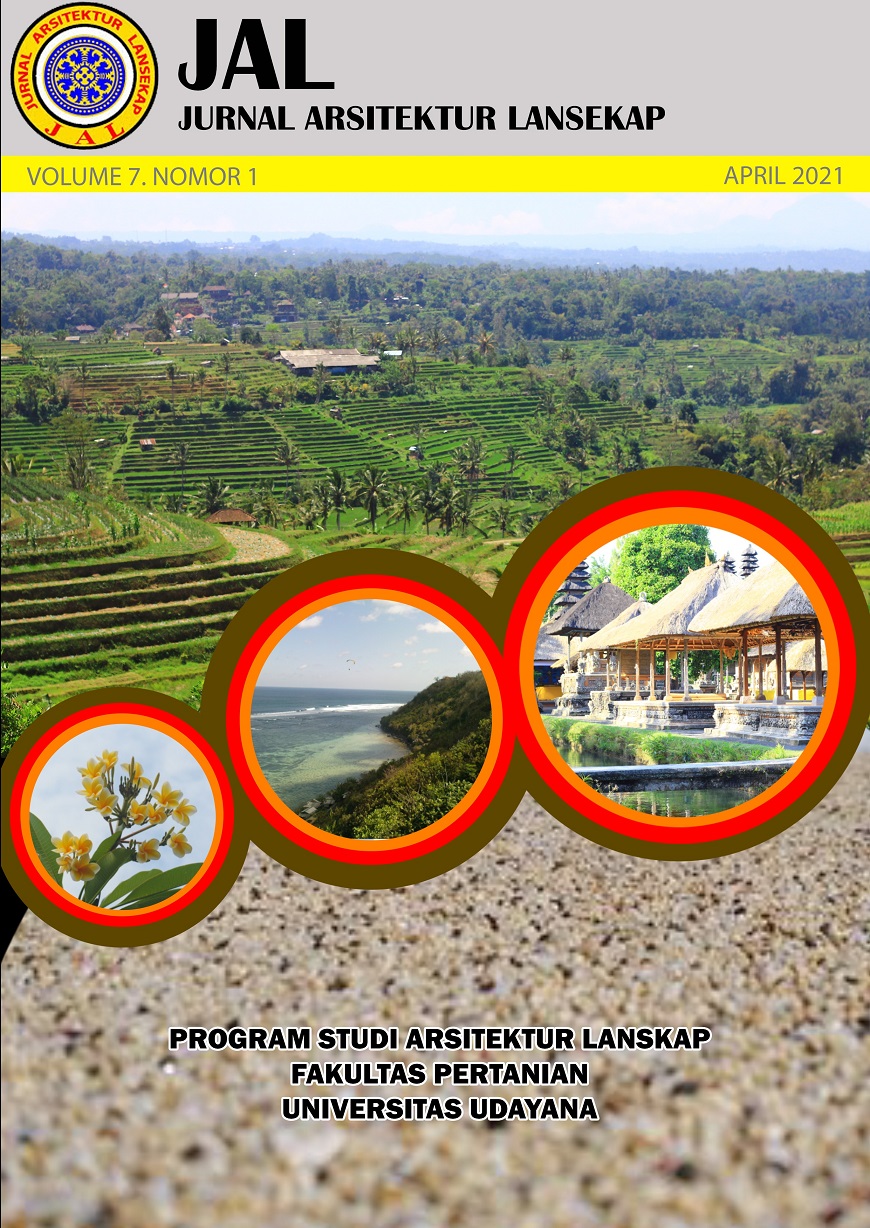Identifikasi cultural landscape di Desa Bayung Gede, Kabupaten Bangli, Provinsi Bali
Abstract
Landscape and culture are important for the sustainability of Bali tourism. The combination of landscape and culture forms a cultural landscape. For the environment, cultural landscape sustainability is very important because it contributes to biodiversity conservation. Bayung Gede Village is a Bali Aga village located in a mountainous area, with geographic conditions consisting of traditional settlements and plantation land. Bayung Gede Village has various uniqueness, but the utilization of its potential for tourism is not optimal. This research is an attempt to identify the potential cultural landscape in Bayung Gede Village. The research method used is qualitative research methods. Data collection techniques were carried out through field observations, in-depth interviews, and literature studies. The data were analyzed by using descriptive analysis techniques. From the analysis, it is concluded that most of the Bayung Gede Village area is a cultural landscape. The unique cultural landscape in Bayung Gede Village is in the form of traditional residential areas, traditional house yards, and sacred spaces. The cultural landscape of Bayung Gede Village is a cultural landscape that is deliberately designed by humans, and an associative cultural landscape, which is a combination of nature and people's beliefs.
Downloads
References
Dwijendra, N. K. A. 2009. Arsitektur & Kebudayaan Bali Kuno. Denpasar: Udayana University Press.
Dwijendra, N.K.A., Manik, I.W.Y. 2007. Transformasi Tipo Morfolofi Hunian di Desa Bayung Gede, Bali. Bali: Malakah Seminar Departemen P.U Provinsi Bali.
Eliade, Mircea. TT. 1987. The Sacred and The Profane the Nature of Religion. New York: Trask W.R. (tr). A Harvest Book.
Gelebet, IN., Meganada, IW., Negara, IM.Y., Suwirya, IM. 1986. Arsitektur Tradisional Daerah Bali. Denpasar: Departeman Pendidikan dan Kebudayaan.
Gunatama, G., Divayana, D.G.H., Parma, IP.G., Sukerti, N.W. 2017. IbDM Geowisata Bali Aga di Desa Trunyan Kecamatan Kintamani-Bali. Prosiding Seminar Nasional Pengabdian Kepada Masyarakat.
Hakim, L., Jae, E.K., Sun, K.H. 2009. Cultural Landscape and Ecotourism in Bali Island, Indonesia. J.Ecol. Field.Biol. 32(1):1-8.
Idedhyana, IB. 2011. Perpaduan Budaya Pada Rumah Tradisional di Desa Bayung Gede. Jurnal Widya Teknik 4(1):49-65.
Jensen, GD, Suryani, LK. 1996. Orang Bali. Bandung: Penerbit ITB.
Kintamani, Camat. Monografi Desa Bayung Gede. 2006. (tidak diterbitkan). Bangli.
Koentjaraningrat. 1974. Kebudayaan, Mentalitet dan Pembangunan. Jakarta: Gramedia.
Manik, IWY. 2007. Pengaruh Demografi, Gaya Hidup, dan Aktivitas, Terhadap Transformasi Tipo-Morfologi Hunian Tradisional di Desa Bayung Gede Bangli. Tesis (tidak diterbitkan) Institut Teknologi Bandung
MF, Mercury. 2019. Tingkat Kunjungan Wisatawan Ke Desa Penglipuran Meningkat. Diakses pada 11 Desember 2020: tersedia pada https://bali.tribunnews.com/2019/12/30.
Mills, J.G. 2007. The Category of the Associative Cultural Landscape as A Mean to Preserve Intangilble Heritage, Especially Oral Literature. Hawai’i volcanoes National Park, as an Example. Master Thesis. (unpublished) Brandenburg University of Technology.
Pastika, MM. 2012. Peraturan Daerah Propisi Bali Nomor 2 Tahun 2012 Tentang Kepariwisataan Budaya Bali. Denpasar: Pemeritah Daerah Provinsi Bali.
Rapoport, A. 1992. On Cultural Landscape. Traditional Dwellings and Settlements 3(2):33-47.
Salamanca, A.M., A. Nugroho, M. Osbeck, S. Bharwani and N. Dwisasanti. 2015. Managing a Living Cultural Landscape: Bali’s Subaks and The UNESCO World Herritage Site. Stockholm Environment InstituteAsia, Bangkok.
UNESCO-ICOMOS. 2009. World Heritage Cultural Landscape. Paris: UNESCO-ICOMOS.
Wahurwgh, A., Dongre, A. 2015. Burhanpur Cultural Landscape Conservation: Inspiring Quality for Sustainable Regeneration. Sustainability 7:932-946
Windia, W, Wiguna, W.A.A. 2013. Subak Warisan Budaya Dunia. Denpasar: Udayana University Press
An author who publishes in the Jurnal Arsitektur Lansekap (JAL) agrees to the following terms:
- Author retains the copyright and grants the journal the right of first publication of the work simultaneously licensed under the Creative Commons Attribution-ShareAlike 4.0 License that allows others to share the work with an acknowledgement of the work's authorship and initial publication in this journal
- Author is able to enter into separate, additional contractual arrangements for the non-exclusive distribution of the journal's published version of the work (e.g., post it to an institutional repository or publish it in a book) with the acknowledgement of its initial publication in this journal.
- Author is permitted and encouraged to post his/her work online (e.g., in institutional repositories or on their website) prior to and during the submission process, as it can lead to productive exchanges, as well as earlier and greater citation of the published work (See The Effect of Open Access).
Read more about the Creative Commons Attribution-ShareAlike 4.0 Licence here: https://creativecommons.org/licenses/by-sa/4.0/.







